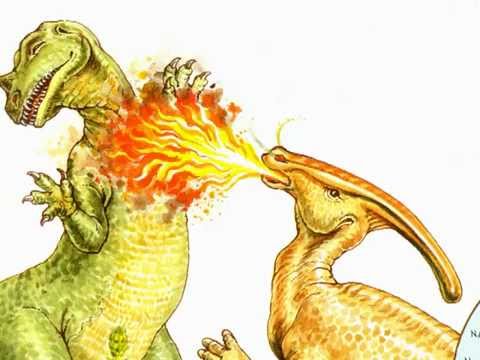It comes from Philip Senter, in a book reviewed by Darren Naish.
The early chapters of this book evaluate and discuss the creationist contention in general and the relatively young history of the entire movement. The impact of John Whitcomb and Henry Morris’s 1961 book The Genesis Flood is obvious, as is the fact that their arguments fail evaluation (Senter 2019). Nevertheless, their influence was such that – from the early 1970s onwards – a number of like-minded individuals were promoting Whitcomb and Morris’s vision, and were in particular arguing that ancient and medieval writings and works of art make explicit reference to dinosaurs and other long-extinct animals. Senter (2019) uses the term apnotheriopia (meaning ‘dead beast vision’) to describe the tendency of creationist author to interpret monsters in literature and art as long-extinct reptiles.
If apnotheriopia is one of your guiding principles, it ‘follows’ that the fire-breathing dragons canonical to Eurocentric, Christian mythology should be interpreted as dinosaurs or similar reptiles, and that such creatures were dragonesque fire-breathers. So integral has the whole fire-breathing thing been to these authors that they’ve proposed fire-breathing for dinosaurs of several sorts (most frequently hadrosaurs) as well as for pterosaurs and the giant Cretaceous crocodyliform Sarcosuchus (Senter 2019). You might know of one or two cases in which this idea has been mooted. Senter’s book shows that numerous authors have engaged with this vision and written about it. The sheer quantity of this literature is daunting – I was going to say ‘impressive’ but this absolutely seems like the wrong word – and Senter has clearly gone to some considerable trouble to obtain it. He must own a pretty hefty personal library of creationist volumes, and I’m reminded of a statement he makes in one of his papers, wherein he notes that collecting and reading creationist literature on dinosaurs and other extinct animals is one of his “guilty pleasures”.
It’s as ridiculous as it sounds, and it is promoted by the inexplicably popular version of creationism favored by Ken Ham and Kent Hovind. If it’s written down in an old text, the older the better, it must be true, because no one in the past had imagination or creativity, or was ever mistaken in an observation, and they must have been literally describing something that actually existed. Therefore, there were dragons, and they breathed fire. Now let’s steal some observations from paleontology and crudely reconcile them with dragons, and voila!
I’ve got my own little library of creationist nonsense, and they do this all the time. Answers in Genesis still pushes this ridiculous idea as essential to justify their dogma that humans and dinosaurs coexisted.



I’m also reminded of Velikovsky and his Worlds in Collision thesis that ancient myths and histories were reliable though somewhat garbled descriptions of cosmological catastrophes, or Von Daniken’s Chariots of the Gods assertion that ancient myths and texts were reliable though somewhat garbled descriptions of invasions by space aliens. In addition to wanting to shoehorn facts to fit theory, there seems to be something satisfying about searching the past for hidden clues to a Big Secret Surprise. You really pay attention to witnesses. Others don’t.
Shouldn’t it be apnosauropia?
I mean, just asking questions…
I thought that the really old descriptions of dragons in mythology typically described them as oversized venomous snakes, and the legs, wings, and breathing fire bits were more recent additions?
I like Aron Ra’s idea that the inspiration for the fire-breathing dragon was the North African and Nile Monitor lizards.
I wouldn’t be surprised if fire breathing dragons grew out of the fact that some snakes spit venom. It would be a pretty easy assumption to make that if a small reptile spits venom then those larger reptiles foreign travellers talked about spit fire.
I see dead beasts. They don’t know they’re dead.
I can’t remember where I read/heard it, but it may be related to what George@ #4 said. The fire breathing dragon legend may have possibly sprung from the story of St. George killing a nile monitor which spawned a legend and was depicted in an 11th century painting. The one-upmanship tendency of artists may have had subsequent European painters adding to the single forked tongue in their own paintings until a multiple forked tongue was interpreted as fire.
I remember coming across a similar interpretation of ancient Greek myths which explained that myths about Griffins may have sprung from ancient people stumbling across a fossil “graveyard”, or myths about Titans from them coming across dinosaur bones. Here’s the link to a good article about a researcher named Adrienne Mayor:
https://www.latimes.com/archives/la-xpm-2000-sep-24-mn-25867-story.html
As this excerpt shows, she’s legit and she’s not arguing that men and dinosaurs lived at the same time, but that when ancient people dug up the fossils which were millions of years old, they made up stories to explain them.
“Merging the fields of paleontology, archeology and classical literature, Mayor’s research has uncovered striking correlations between modern fossil finds and many of the myths and folk tales that sprang up in early Western civilization. Bolstered by evidence linking contemporary dig sites to the origins of monsters and heroes in ancient texts, Mayor theorizes that these myths contain at their core a surprisingly sophisticated attempt to explain the sudden appearance of bones of immense proportions.”
I used to teach my students that by studying a culture’s myths, we might learn a lot about that culture and learn about “a grain of truth” behind the myth. Mayor seems to agree with this.
Cartomancer, and other folks here with knowledge about this – what do you think?
https://en.wikipedia.org/wiki/Chinese_dragon
I find this believable though I’m not sure it’s as well-established as Wikipedia suggests. I am not even sure that informal Chinese language makes a distinction between dragons and dinosaurs. Both are 龙 (lóng).
I occasionally experience sleep apnotheriopia.